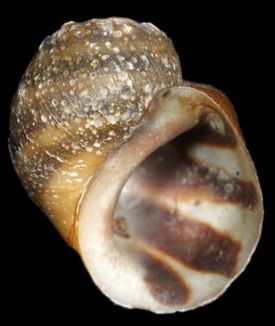Round rocksnail
The Round rocksnail (Leptoxis ampla) is a threatened species of freshwater snail endemic to certain free-flowing streams in Alabama. The round rocksnail is an aquatic gastropod mollusk in the family Pleuroceridae, characterized by having a gill and an operculum. It was first described in 1855 by Harvard malacologist John Gould Anthony.
The round rocksnail is a pleurocerid snail and its shell grows to about 20mm (0.8 in) in length. The shell is subglobose, with an ovately rounded aperture. The body whorl is shouldered at the suture, and may be ornamented with folds or plicae. Color may be yellow, dark brown, or olive green, usually with four entire or broken bands.
Lydeard et al. (1997) found slight differences in DNA sequencing between the painted rocksnail and the round rocksnail, and considered them to be sister species. Following analysis by allozyme electrophoresis on these same species, Dillon speculated that the two species represented isolated populations belonging to a single species. The two species are geographically separated, with the painted rocksnail inhabiting Coosa River tributaries, while the round rocksnail is the only surviving rocksnail species in the Cahaba River drainage. Both species are currently recognized by the malacological community.
Habitat
Rocksnails are gill breathing snails found attached to cobble, gravel, or other hard substrates in the strong currents of riffles and shoals.
The round rocksnail was historically found in the Cahaba River and the Little Cahaba River, in Bibb County; and the Coosa River in Elmore County, and tributaries—Big Canoe Creek and Kelly's Creek in St Clair County; Ohatchee Creek in Calhoun County; Yellowleaf Creek in Shelby County; and Waxahatchee Creek in Chilton County. The type locality is Alabama.
The round rocksnail is currently known from a shoal series in the Cahaba River, Bibb and Shelby counties, and from the lower reach of the Little Cahaba River, and the lower reaches of Shades Creek and Six-mile Creek in Bibb County.
Life cycle
Adult rocksnails move very little, and females probably glue their eggs to stones in the same habitat. Longevity in the round rocksnail is unknown; however, it was reported as having a short life span
Decline
The round rocksnail has disappeared from more than 90 percent of its historic range. The curtailment of habitat and range for this (and few other snail species) species in the Mobile Basin's larger rivers is primarily due to extensive construction of dams, and the subsequent inundation of the snail's shoal habitats by the impounded waters. This snail has disappeared from all portions of its historic habitats that have been impounded by dams.
Dams change such areas by eliminating or reducing currents, and thus allowing sediments to accumulate on inundated channel habitats. Impounded waters also experience changes in water chemistry, which could affect survival or reproduction of riverine snails. For example, many reservoirs in the Basin currently experience eutrophic (enrichment of a water body with nutrients) conditions, and chronically low dissolved oxygen levels. Such physical and chemical changes can affect feeding, respiration, and reproduction of these riffle and shoal snail species.
The species was listed as threatened on the U.S. Fish and Wildlife Service's list of endangered species on October 28, 1998. It is also listed as a "vulnerable species" by the International Union for Conservation of Nature.
References
- U.S. Fish and Wildlife Service. (2005). Recovery Plan for 6 Mobile River Basin Aquatic Snails. U.S. Fish and Wildlife Service, Jackson, Mississippi. 46 pp. pages 11-12 and page 15.
- Goodrich C. (1922). "The Anculosae of the Alabama River Drainage". Miscellaneous Publications, Museum of Zoology, University of Michigan (7): 1-57.
- Fish and Wildlife Service. (28 October 1998). "Endangered and Threatened Wildlife and Plants; Endangered Status for Three Aquatic Snails, and Threatened Status for Three Aquatic Snails in the Mobile River Basin of Alabama". Federal Register 63(208), Rules and Regulations, Accessed 26 January 2009.
- Burch J. B. (1989). "North American freshwater snails". Malacological Publications, Hamburg, Michigan. 365 pp.
- Turgeon D. D., Quinn J. F. Jr., Bogan A. E., Coan E. V., Hochberg F. G., Lyons W. G., Mikkelsen P. M., Neves R. J., Roper C. F. E., Rosenberg G., Roth B., Scheltema A., Thompson F. G., Vecchione M. & Williams J. D. (1998). "Common and scientific names of aquatic invertebrates from the United States and Canada: mollusks". Am. Fish. Soc. Special Publication 26: 36.
- Bogan A. E. & Pierson J. M. (1993). Survey of the aquatic gastropods of the Cahaba River Basin, Alabama: 1992. Alabama Natural Heritage Program. Contract Number 1922.
- Alabama Department of Environmental Management. (1994). Water quality report to Congress for calendar years 1992 and 1993. Montgomery, Alabama. 111 pp.
- Alabama Department of Environmental Management (ADEM). (1996). Water quality report to Congress for calendar years 1994 and 1995. Montgomery, Alabama. 144 pp.
